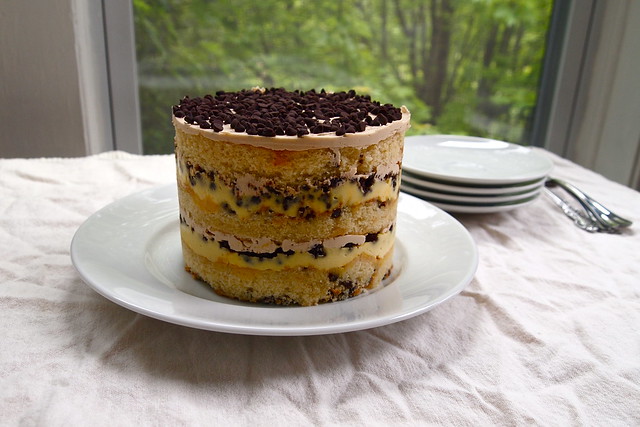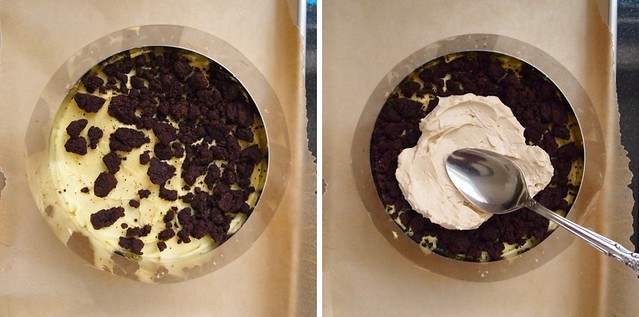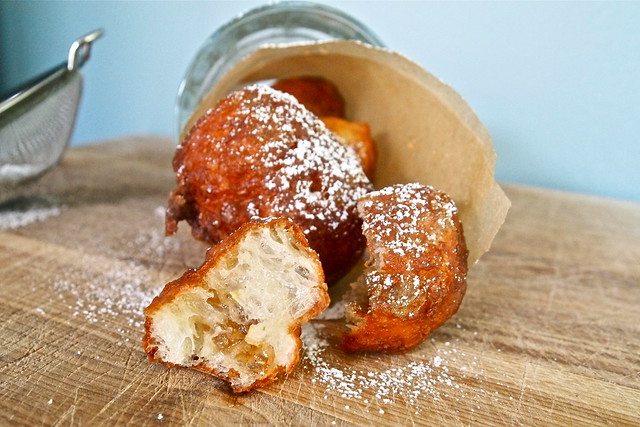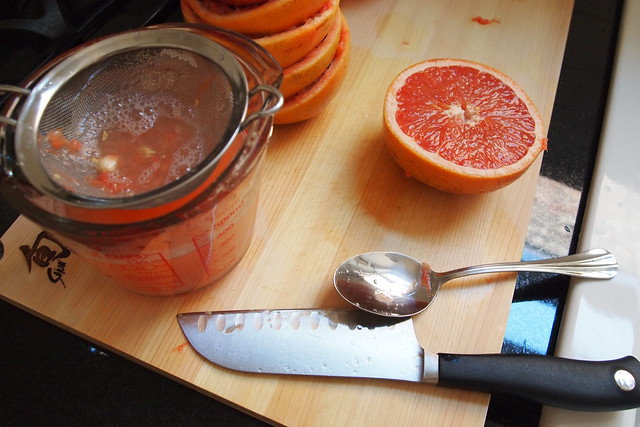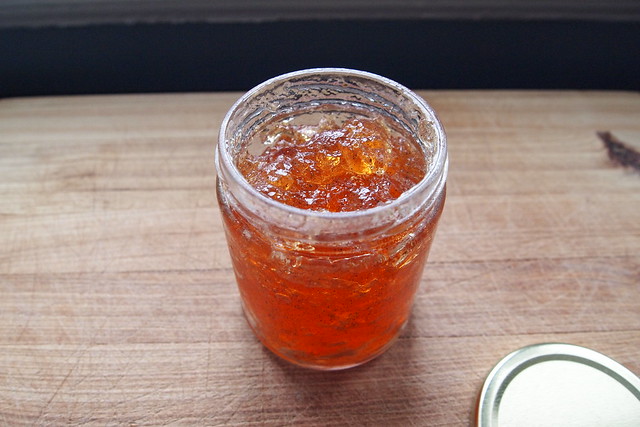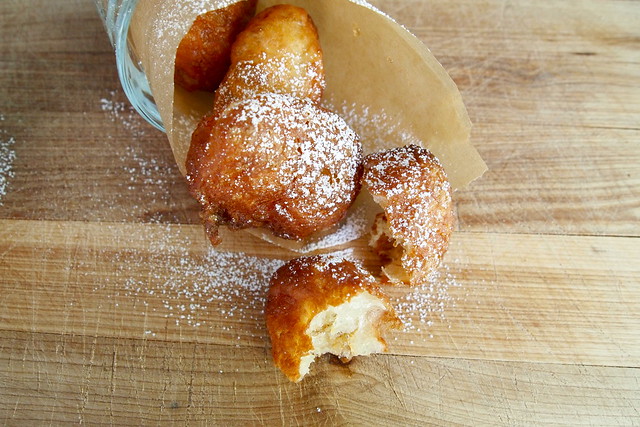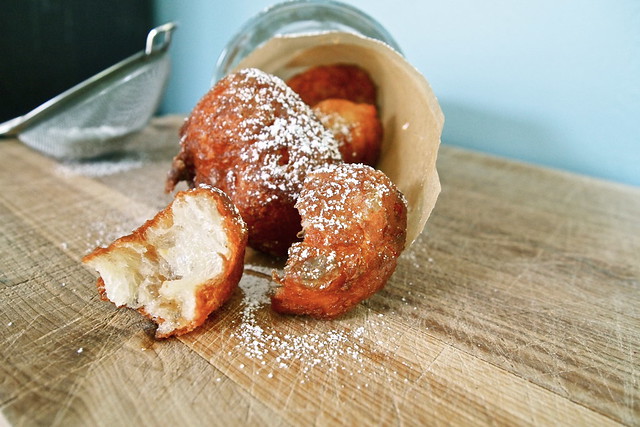This past weekend, we celebrated Octavian's birthday. We put down our books. We strolled out in the sunshine. We sipped on dulce de leche milkshakes. We cleaned decades' worth of dust off the LPs that belonged to Octavian's late grandfather. We let the needle drop and sat back as Ella's voice filled the room. It was a wonderful moment. These records had sat untouched for years in Octavian's grandparents' home in Romania. Many of them were British pressings of 1960s pop and jazz smuggled into the country during the Ceaușescu regime. It felt good to be able to give them a new life in our home.
And, of course, there was cake. The folks at Momofuku Milk Bar call this one a chocolate-chip layer cake, but that, I think, hardly captures it. What makes this cake worthy of a chorus of oohs and aahs are the bright ribbons of passion-fruit curd running through it, bold, tart, and unmistakably tropical. The curd plays brilliantly with the other elements--coffee frosting, chocolate crumb, chocolate-chip cake--and lingers just a little in the mouth, exotic and floral. It is wonderfully good stuff.
Without a doubt, in fact, it's the best stuff I've made out of the Milk Bar cookbook. I am crazy about this curd. I wish I'd made more last week--enough to smear on toast, to swirl into yogurt, to sandwich between bittersweet-chocolate-wafer cookies, to eat by the spoonful. It is that good.
Admittedly, this curd does demand a little more of you than the typical curd. You'll need a blender and some gelatin. But it's worth it. The addition of gelatin gives this curd serious body. Most curds rely only on eggs for thickening, and while that's fine for toast, curd made that way won't hold up in a cake or sandwiched between cookies. This curd, by comparison, is versatile. Let your imagination run wild. Whatever you come up with, this curd will not be out of place.
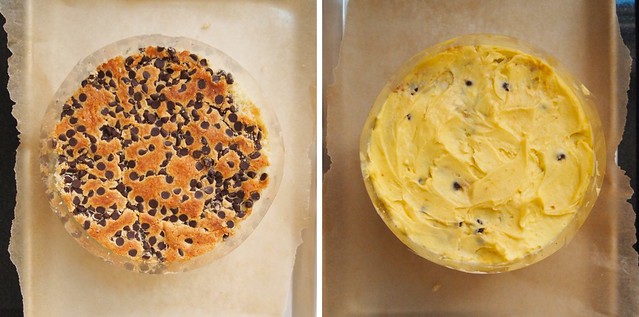
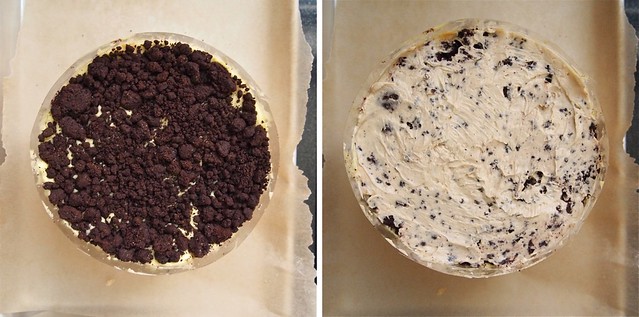
And if you're wondering, Octavian and I really liked the cake as a whole. Passion fruit, coffee, and chocolate are amazing together (and make for a far more balanced cake than the chocolate-malt, if you ask me). But in our heart of hearts, we're still apple-pie layer cake people.
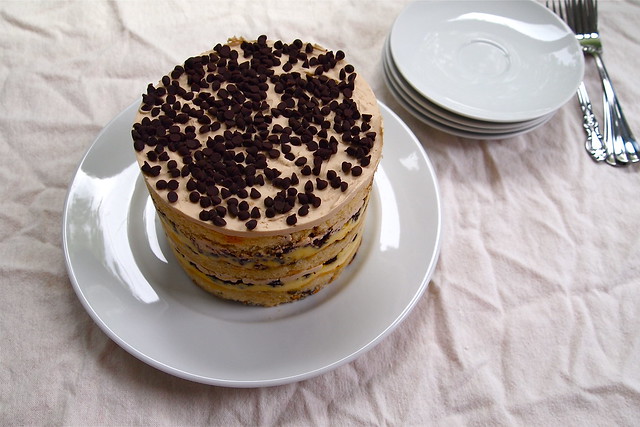

Passion-fruit Curd
Adapted from the Momofuku Milk Bar Cookbook
Note: About the passion fruit puree. There are a number of online vendors that sell very high-quality frozen fruit purees, but with overnight shipping and the quantity of puree recommended to ensure that it all stays cold, it can add up. I recommend that you check the freezer aisle of Latin markets in your area first. Chicagoans, I found more than enough El Sembrador passion fruit puree for this recipe for about $3 at Tony's Finer Foods in Logan Square. I was pleased with the quality.
100 g / 1/2 cup passion fruit puree
65 g / 1/3 cup sugar
2 eggs
1 gelatin sheet or 1/2 teaspoon powdered gelatin
170 g / 12 tablespoons (1 1/2 sticks) butter, very cold
2 g / 1/2 teaspoon fine sea salt
Put the passion fruit puree and sugar in a blender and blend until the sugar granules have dissolved. Make sure to scrape under the blender's blades--granules tend to deposit there. Add the eggs and blend on low until you have a bright-orange-yellow mixture. Transfer the contents of the blender to a medium saucepan. Clean the blender canister.
Bloom the gelatin. Soak the sheet in a small bowl of cold water. The gelatin is bloomed when it has become soft, after about 2 minutes. If the gelatin still has hard bits to it, it needs to bloom for longer. If it is so soft it is falling apart, it is overbloomed; discard the gelatin and start over. Gently squeeze the bloomed gelatin to remove any excess water before using.
Heat the passion fruit mixture over low heat, whisking regularly. As it heats up, it will begin to thicken; keep a close eye on it (this can take awhile--at least 15 minutes, in my experience). Once it boils, remove it from the stove and transfer it to the blender. Add the bloomed gelatin, butter, and salt and blend until the mixture is thick, shiny, and super-smooth.
Transfer the mixture to a heatproof container and put it in the fridge until the curd has cooled completely, at least 30 minutes. The curd can be refrigerated for up to 1 week. Do not freeze.
Makes about 1 cup.
Technical Notes for Milk Bar's Chocolate-chip Layer Cake
The directions for this cake were, for the most part, straightforward. Below are a few points of obsessive detail that you might find helpful when making the cake.
- Passion-fruit curd: when you're dissolving the sugar into the puree in the blender, give the underside of the blades a scrape with a spatula before proceeding on. Sugar tends to deposit there, and you want that sugar in your curd.
- Cake mixing: be warned--the chocolate-chip cake has far more liquid than the other Milk Bar cakes, so you really need to mind Tosi's mixing instructions with this one. I mixed my cake batter for the six minutes required, and still my cake almost baked out of its quarter-sheet. It was also less dense than it should have been and was more difficult to work with as a result. The lesson: mix, mix, mix!
- Chocolate chips: I'm not really sure why Tosi wants you to scatter the chips over the batter just before baking. Why not just fold them in by hand before spreading the batter over the quarter-sheet? Nearly all my chips stayed at the surface of the cake. I think the final cake would have had more visual appeal if you could see the chips in the profile of each of the cake rounds.
- Serving: This cake was by far the easiest to cut slices out of. With previous Milk Bar cakes, I've had the slices collapse on me while trying to transfer them to a plate. Keep this cake cold enough, and it will slice beautifully. That said, I recommend, if you can manage, waiting for the cake slices to come up to temperature a little before digging in, at least 10 minutes. Cold, hard mini chocolate chips just don't have that much appeal.
- Height: This layer cake was noticeably more stout than other Milk Bar layer cakes I've made. I chalk that up to the cake's components--they don't give the cake as much height as some others.
P.S. If you're looking to make the whole cake, you can find the recipe posted here.

